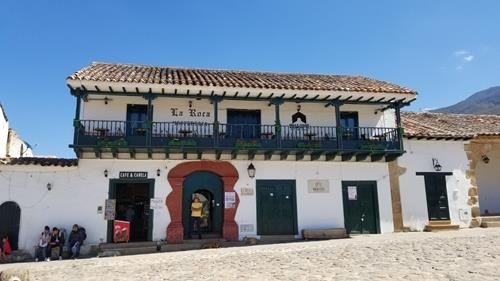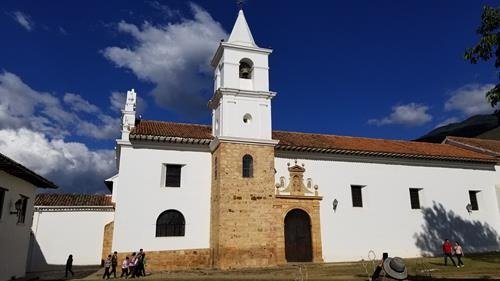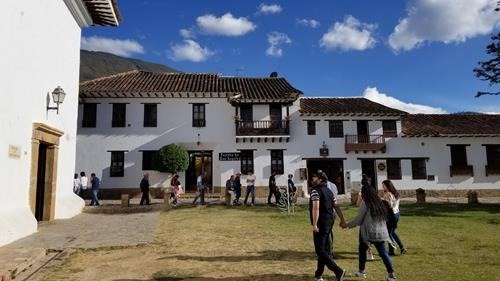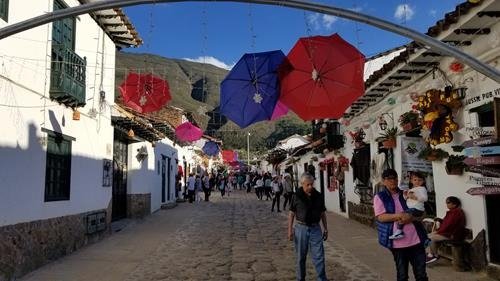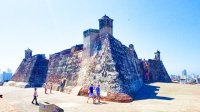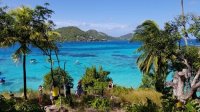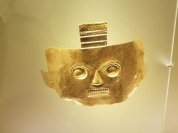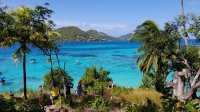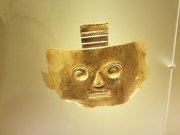To help support the expenses of hosting this blog, some of the links on this website are “affiliate links.” This means that, if you click on the link and purchase an item, I will receive a small commission from the seller; there is no added cost to you.
BACKPACK AND SNORKEL TRAVEL GUIDE FOR Villa de Leyva - Colombia PURPLE GUIDE
This Backpack and Snorkel Travel Guide (Villa de Leyva Purple Guide) provides information about the best things to do in Villa de Leyva and ensures that you will be Making Memorable Moments on a relaxing vacation in Villa de Leyva. It includes a self-guided walking tour of Villa de Leyva.
Why you should visit Villa de Leyva (map)
This small historic town is like a step back into the 17th century with its wonderfully preserved downtown area featuring the central plaza (Plaza Mayor) and its many beautifully historical buildings and its relaxed atmosphere. It is truly a world away from busy Bogota.
The downtown area is walkable; as a matter of fact, driving on the narrow and often one-way or pedestrian-only cobblestone streets is discouraged. Once you get out of the historic downtown area, getting around by bike, car, taxi or ATV is easy.
How to get to Villa de Leyva and back
We had originally planned to take the bus from our hotel in Bogota to Villa de Leyva and changed our mind at the last minute to try Uber. I used the Uber app to call an uber and when the uber arrived we learned that he will not accept credit card payments like in the US, only cash.
After talking to some other people, it seems that some Uber drivers in Colombia don’t accept credit card payments, especially for long rides.
So, we ended up cancelling the Uber ride and asking our hotel to call a taxi and bring us to Terminal del Norte.
At Terminal Norte (map), there were long lines for all the bus companies. We saw 2 ticket counters from Reina and stood in line for those. I confirmed with the person in front of me that this was indeed the Reina line and he said yes. He then asked where we go and I said Villa de Leyva. He was a little skeptical as the writing on the Reina ticket booth said nothing about Villa de Leyva. After a few minutes and talking to his wife, he pointed us to the Valle de Tenza booth which clearly said “Villa de Leiva”, so we got in their long line. One of the 2 ticket agents saw me and pointed to the “Villa de Leiva” sign and after I nodded he signaled me to jump the line and buy my tickes immediately. I paid 25,000 pesos per person. After I asked, he confirmed that this is a direct bus and he said that we should rush to bus stop 4 (the Valle de Tenza stop) in the departure area. My ticket said bus 534 departs at 10:00am and ticket sold at 10:10am. The bus arrived at 10:40am and we left at 10:50am.
By the way, during the time we waited for our bus besides us, in bus stop 3, were 2 buses that arrived and left from Alianza (another bus company) that had Villa de Leyva signs on them.
Our bus had 20 seats, 19 for passengers and 1 for the driver and all were sold. We may have bought the last 2 seats on this bus. I think the bus probably had A/C, but it was never turned on and the windows could not be opened, so it got warm. The only air flow came from the open driver’s window. The seats were very soft and comfortable and I had enough leg room and I am 6’4″ (192cm).
Because another passenger asked, there was a brief bathroom break a few minutes after Samaca.
We arrived at the Villa de Leyva bus terminal (map) at 1:30pm.
There were at least 10 buses. The bus station is about 3 blocks away from Plaza Mayor.
On the way back to Bogota, we used Reina. The bus was very similar with 19 passenger seats and 1 driver seat.
Many of the side windows could be opened, but I believe the legroom was smaller. The seats were only half sold, so the bus stopped 4 times to pick up additional passengers on the way to Tunja. Those additional passengers all left in Tunja.
We left Villa de Leyva at noon, arrived at the Tunja bus terminal at 1:10pm and departed at 1:15pm.
On the way to Bogota, the bus stopped many times to pick up and drop off more passengers. Some passengers even had to stand.
The bus did not stop at Terminal Norte, but a little North of it as some people wanted to get off.
We arrived at the downtown bus terminal at 4pm. There are supermarkets and restaurants nearby. From there, it was only an 8km or 10,000 Peso taxi ride to our hotel near the airport.
Where to stay in Villa de Leyva
Hotel Esquina Colonial (map) is an inexpensive but rustic hotel close to Plaza Mayor and only a short walk from the bus terminal in Villa de Leyva.
As it turned out, the owner also works as a booking agent at the bus terminal for the Reina long distance buses.
The hotel is built in a beautiful colonia style and, eve though the street outside is fairly busy, it was quiet inside the building. It is clean and well maintained, but has spartanic furnishing. The hotel serves breakfast; as usually in Colombia, breakfast is not buffet style.
Wifi was comparably fast and reliable.
The owner is very friendly; he speaks some English and he is good to talk to.
For Pinterest users, here is a pin that you can use:
Self-guided walking tour of Villa de Leyva
This self-guided walking tour of Villa de Leyva covers Villa de Leyva’s historic downtown area which is very walkable and safe. While I feel honored if you follow my self-guided walking tour below, I like to encourage you to just wander off and explore the many side streets and the beautiful buildings and places. Please tell me about your discoveries – I like to hear them.
As our hotel was close to Plaza Mayor, the major attraction of Villa de Leyva and a focal point of the local culture, we start our tour at the plaza.
Plaza Mayor (map)
Plaza Mayor is one of the largest town squares in the Americas. The layout of the downtown area is such that most streets seem to lead to this massive cobblestone plaza. In the center of the plaza is the small Mudejar fountain, which provided water to the village for nearly four centuries. Plaza Mayor is surrounded by beautiful colonial buildings, many of which house restaurants, souvenir stores, a bank, the Casa Museo de Luis Alberto Acuña museum, etc. The main focal point, however, is the Iglesia Parroquial church.
Iglesia Parroquial (map)
Built in 1608, this church is one of two churches in Villa de Leyva currently used for religious services. There is no entrance fee, so walk in and explore this church which has not changed for centuries. When we first got there, we found one of the side doors inside the church unlocked and wandered through some adjacent beautifully decorated rooms and got a view of a nice courtyard behind the walls. At a later point, this door was locked.
Casa Museo de Luis Alberto Acuña (map)
This museum is located pretty much on the opposite side of Plaza Mayor. It showcases the works of Colombia’s most influential painter, sculptor, writer and historian: Luis Alberto Acuña. He resided in this building for the last 15 years of his life.
Iglesia del Carmen (map)
Iglesia del Carmen is the other of the 4 churches in Villa de Leyva that is still used for religious services. It is located one block off Plaza Mayor and, as the name suggests, the church honors Our Lady of Mount Carmel, as the patron saint of the parish. If it is open, take a look at the paintings on the inside. If you are interested, you can also visit the Museo del Carmen which showcases religious artifacts.
Visit the House of the First Congress of the United Provinces
You can visit the House of the First Congress of the United Provinces, where Colombia’s First Congress of the United Provinces of New Granada met and drafted the first laws of Colombia. At this very point, in October 1812, now famous politicians like Simon Bolívar, Antonio Nariño, and Camilo Torres were present.
Museo del Chocolate de Villa de Leyva (map)
This is really more a chocolate shop than a “museum” and it is located right off the main square to the North. Visit it and buy some chocolate as you like.
Since all chocolate that I buy seems to disappear in record time, I cannot confirm if the rumor is true that their chocolate is made fresh and does not have preservatives in it and thus it turn bad if not eaten within a few days.
Casa Teracotta (map)
Casa Teracotta, is not a must-see attraction and it seems a bit out of place in a historical place like Villa de Leyva. Anyway, it is a big Fred Flintstone style pottery house and apparently the biggest of its kind in the world. You can go inside and on the roof.
Casa Terracotta is open daily from 9am-6pm, is a little difficult to find, so make sure to have a map handy or get a taxi. You can drive up and someone will find you and take the $7,000 Peso admission.
Mueso el Fósil (map)
This museum was built around a completely intact Pliosaurus (oceanic dinosaur) fossil that a local farmer unearthed at this place in the 1970s. It is about 100 million years old.
The museum is open from 8am to 5pm and has a small admission. There is also a restaurant and gift shop on the premises.
Los Pozos Azules (map)
Los Pozos Azules (= “The Blue Wells”) are a five man-made turquoise-green artificial lakes that some tourists go to for a swim in the half desert. We did not go there as I had enjoyed a swim in Chile’s Atacama Desert a few months earlier. Los Pozos Azules carry a hefty admission fee of (currently) xxx Pesos. When you go there, be prepared to pay cash.
As I mentioned earlier, I like to encourage you to wander off and explore this beautiful city. Here are more photos of sites that you may see that way:
Here are descriptions and tours of the destinations that we visited:






